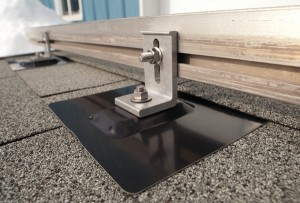EcoFasten Solar uses its roofing expertise to manufacture solar attachment hardware.
Shingles, tiles, slates, metal, rubber, thermoplastic, mud, grass, sticks — anything can be thrown on top of a roof for protection. And when someone wants to put a solar array on top of that mess of materials, knowledge of that roof trumps knowledge of how a solar array should be pieced together.
That’s what EcoFasten Solar, a manufacturer of steep slope roof attachment hardware for the solar industry, believes. The Morrisville, Vt.-company has a strong background in roofing, and owner Brian Stearns says that’s what constitutes a successful solar installation.

LESS DISRUPTION
The GreenFasten mounting hardware secures with one fastener directly through the flashing. QuikFoot, EcoFasten’s other popular mounting product, uses two fasteners hidden by the flashing.
“I think the difference between EcoFasten and our competitors is that we are roofing people that make water-tight components for the roofing industry,” Stearns says. “[Our competitors] are electrical contractors who make roofing attachments for the electrical industry that may not be roofing-friendly. Our competitors all seem to be electricians who needed to have a part that would allow them to attach an electrical component to the roof. But they don’t understand roofing.”
ROOFING WISDOM
In the ’70s and ’80s, Stearns honed his skills in the roofing industry, and after years of hard work, he realized the physical demands of roofing were not suitable for a lengthy career. So in 1992, Alpine SnowGuards was born. Stearns took his roofing experience and transferred it into a snow retention system manufacturing business, preventing avalanching snow off sloped rooftops. Seeing a way to use its design and manufacturing expertise in the maturing renewable energy industry, Alpine SnowGuards introduced a new division — EcoFasten Solar — in 1996.
Stearns saw a disconnect between the roofing industry and solar integrators. Not all roofs are the same, so solar racking and mounting products shouldn’t be treated as one-size-fits-all. EcoFasten has products for commercial/flat rooftops, but its real bread and butter is with steep slope roofing — essentially residential installations. For metal roofs, there’s the Simple Seal product, and for shingle, slate and tile roofs QuikFoot came first, followed by GreenFasten.
“QuikFoot was initially well received, but the integrators at the time felt that it was too expensive,” Stearns says. “So we went back to the drawing boards and came up with a part that we call GreenFasten that is more of a flush-mount kind of assembly that is not as costly.”
QuikFoot uses two fasteners while GreenFasten and most competitors use one. One-fastener systems might cost less because there are fewer components, but sometimes a cheaper system isn’t the best choice.

QUICK CONNECTION
The QuikFoot product has a baseplate that is fastened to the roof with a flashing over top. All EcoFasten mounting hardware is watertight and secure.
“In areas with high wind uplift or in areas where there is a rack component that is strong enough to span a greater distance, the QuikFoot part will probably save money,” Stearns says. “It’s still a more expensive part than a GreenFasten, but it’s probably more cost effective in those higher demand zones.”
The QuikFoot product has a baseplate that is fastened to the roof, with a flashing that goes overtop the baseplate. GreenFasten has no baseplate; the fastener is secured through the flashing.
“The baseplate component is missing from most of the products in the industry,” Stearns says.
EcoFasten focuses just on roof attachment hardware. No rails, racks or other BOS components are in the company’s product lineup.
“EcoFasten Solar focuses on water-tight, structural roof attachment hardware, period,” Stearns says. “We don’t get involved with the racks or panels or inverters, just the attachment hardware. Ninety-nine percent of the time, rails are attached to our components; however, there are a couple people looking at our products for attaching panels directly to a component that they may make.”
FUTURE PROGRESS
Stearns says there is room for evolution in residential solar construction. Building-integrated photovoltaics (BIPV) might one day be a threat to business, but right now things are going well for EcoFasten.
“[Solar shingles] have been talked about and kicked around now for 10 years probably, and I don’t know anybody who is actually installing them. It hasn’t affected our market at all,” he says. “In fairness, it could be because the market is growing quickly enough that our market has not been affected even though there is some of that coming into play. We’re just not affected.”
EcoFasten will continue to focus just on roof attachment hardware and improve its products.
“I think that the industry is looking for a solution that will save money, and what appears to be on everyone’s target is racks,” he says. “How can you reduce the cost of racks and reduce the number of attachment points to reduce the overall costs? The QuikFoot component answers the question of a stronger component that will allow less parts to be used. I think that there are companies out there working on eliminating racks, but I just don’t see any yet that are cost-effective.”
Overall, EcoFasten isn’t too worried about eliminating racks or solar shingles. The company knows roofs, and there will always be shingled, tiled, rubbered and mud-covered roofs to worry about.
— Solar Builder magazine
[source: http://www.solarbuildermag.com/featured/ecofasten-solar-roofing/]

Leave a Reply
You must be logged in to post a comment.